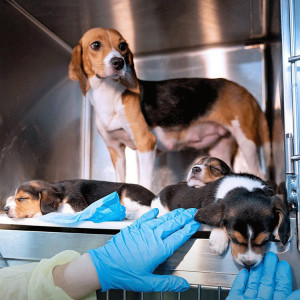The Beagle Freedom Project
Helps ease retired lab Beagles into new lives, and a whole new world.
Despite the open door, the sturdy little Beagle huddled inside the transportation kennel; it took him 10 minutes to put a paw tentatively on the unfamiliar surface, then move completely outside, high-stepping all the way. It was the first time this adult Beagle had ever walked on grass.
Everyone loves stories about dog heroes—the police dog who leads the chase for an armed criminal, the military dog who goes ahead of the troops to sniff out hidden bombs or the service dog whose devotion and skill give a person with a disability greater independence.
Trick question: All dogs are perfect! But find out which type is the best fit for you.
But what about the thousands of dogs who sacrifice years of their lives—or even their very lives—to science’s controversial pursuit of everything from cures for deadly diseases to safe cosmetics? Who speaks for them?
Advocating for Lab Animals
In December 2010, the Beagle Freedom Projectopens in new tab joined the list of those who advocate specifically for these small hounds, and since then, it has mounted multiple efforts on their behalf. Founded by animal-rights attorney Shannon Keith to help a group of Beagles she learned were about to be released and needed homes, Beagle Freedom Project now has several full- or part-time paid staff and has helped place or foster more than 2,000 lab dogs since its inception. (Keith also founded BFP’s parent organization, Animal Rescue Media Education.)
How much do you spend on your pet per year?
More than 95 percent of the dogs used in research are Beagles. The same attributes that make them great family pets—“docile, people-pleasing, forgiving, gentle, easy to care for”—also make them desirable research subjects, says Kevin Chase, director of operations for Beagle Freedom Project.
Beagle Freedom Project had its first legislative victory in 2014 when Minnesota Governor Mark Dayton signed into law an act that requires the state’s higher-education research and related facilities receiving public money to offer their dogs and cats to non-profit animal rescue organizations when the animals are no longer needed.
Passing Laws to Protect Animals
The law, based on BFP’s “Beagle Freedom Bill,” was a modest first step. Since then, California, Connecticut, Delaware, Illinois, Maryland, Nevada, New York, Rhode Island, Washington, and Oregon have all passed similar laws. Other states will follow, Beagle Freedom Project organizers hope.
“The law is meant to bridge two sides of a very polarizing debate over animal research,” says Minnesotan Chase, who spearheaded the law in his home state. Although Beagle Freedom Project opposes any use of animals in research, the legislation is intended to allow adoption as an option for “retired” research dogs and cats. It fills the regulatory gap between the care animals are mandated to receive while being actively used and what happens afterward, when they’re no longer needed.
“If a dog is at the end of its utilization with research and can be placed with a family, why not? It just makes sense,” says Minnesota Senator Scott Dibble, who authored the Minnesota legislation along with Representative John Lesch. But though it did indeed make sense, it wasn’t easy. As Dibble admits, “It turned out to be a little more contentious than we anticipated.”
In 2013, when the idea for the law was first floated, the University of Minnesota—which, along with the Mayo Clinic would be the most affected—was reluctant to support it, and the bill was shelved. Then in 2014, Dibble and Chase approached the university again and got, if not support, at least no overt opposition.
The Minnesota law includes a provision that eliminates certain liabilities for research facilities that release lab animals, something the university requested in discussions with Chase and Dribble, according to the Office of the Vice President of Research.
In statements released through Communications Director Andrea Wuebker, that office said of the law, “This legislation allows the university opportunities to do what we can to offer dogs and cats, available after the study concludes, for adoption without threat of liability by potential or future owners regarding any unforeseen behaviors by the animal. What this law will do is help us partner with outside groups to make available animals for adoption, should the animal not be adopted by the researcher or persons close to the animal, at the end of the study.”
Reporting Animals Used in Labs
A U.S. Department of Agriculture report cited 317 dogs and 278 cats as being used in research at the university in 2013. Of those, 307 dogs and 273 cats were from humane societies or other animal shelters, or were student-owned animals, and were returned to the shelters or students after use.
That number is, however, a fraction of the 4,148 dogs listed for research in Minnesota in the fiscal year 2012 USDA report. Minnesota ranked fifth in the nation that year in the number of research dogs. With 9,434 dogs, Wisconsin ranked first, and in the United States as a whole, the report cited 72,167 dogs and 24,578 cats.
HSUS estimates that 25 million “vertebrate animals” are used each year in research, testing or education, while the USDA tallied 1,110,199 animals in their FY 2012 report. After mice, rats and birds, research animals used that year—in descending order of frequency—included guinea pigs, rabbits, hamsters, non-human primates (including monkeys and chimpanzees), farm animals (including pigs and sheep), dogs and cats.
At the University of Minnesota, research involving animals is mostly medically-based, according to the Office of the Vice President of Research, related to cardiovascular devices, isolated working heart models, and dental implants as well as understanding and treating strokes, epilepsy, overactive bladder syndrome, and other human or veterinary diseases.
Ending the Use of Animals in Research
Like the Beagle Freedom Project, HSUS advocates an end to the use of animals in research, particularly in product testing, encouraging companies to use some of the 5,000 chemicals already tested and approved for human use. Others believe that animals have and still play a critical role in the development of life-saving treatments.
“Indeed, if one reviews the history of medical science, it is clear that every major medical advance has depended on animal experiments … Almost every vaccine used by humans had to be first tested on animals to ensure that it would be safe and effective. Insulin, which has saved millions of diabetics from an early and painful death, was discovered through research on dogs; until relatively recently, the only way to test insulin during the purification process was to inject it into mice and monitor the effect on their blood sugar,” the late John Vane, a Nobel Prize-winning British pharmacologist, said in a “Pfizer Forum” speech.
A New World For Former Research Dogs
Both under the Minnesota law and elsewhere around the country, when laboratory animals are made available for adoption, their actual research history is rarely, if ever, disclosed. That makes it difficult to predict the animals’ adjustment needs. In general, however, Beagle Freedom Project has found that many of the Beagles they place are not house-trained, and tend to be shy around people and new situations, certainly at first. Also, because laboratory diets are generally formulated to reduce the amount of cleanup necessary, the dogs initially have digestive trouble with the richer food commonly fed to companion animals.
“On the whole,” says Chase, the dogs “have never been on grass, have never been on a leash for a walk, they’ve never been on steps. They’re like adult puppies; the whole world is new to them.”
To date, Beagle Freedom Project has received lab dogs—and cats and a pig—from California, Colorado, Nevada, Massachusetts and New Jersey as well as the Midwest, and has had great success both in fostering these lab-released dogs and then matching them with appropriate families. None of their adoption placements has been returned, even from the group of 40 Beagles flown from Spain who were suffering severe health and anxiety problems. The search for additional adoption and fostering homes is, of course, ongoing.
Sometimes, the organizers themselves end up providing the first line of fostering. Kevin Chase already had Junior, now seven and rescued when he was four. But when Chase organized a gathering to solicit foster parents for 10 former lab Beagles, he ended up bringing home Raymond, three, the last Beagle in the room.
“We let the families and the dogs kind of choose each other,” Chase says of the December gathering. “I wasn’t anticipating taking home one of the dogs, but nobody chose Raymond because nobody could catch him. He was afraid of everybody … I said, ‘Come on, buddy. You’re coming home with me.’ Once we got home, he wasn’t going anywhere.” Chase chuckles about how quickly “fostering” became “adopting” with Raymond. These days, he says, Raymond “loves his walk, loves lying in the sunshine.”
Some day, Beagle Freedom Project might be able to add a Minnesota senator to its list of adopters. “If my life ever calms down so that I can be home,” dreams Dibble, “I’m totally going to get a lab Beagle.”








